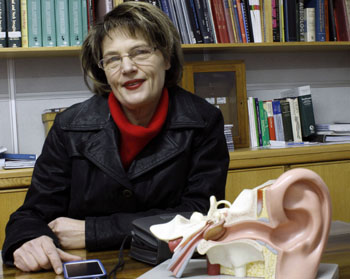 Dr Magteld Smith |
A researcher at the University of the Free State is part of an overseas audiological breakthrough, after receiving a newly developed cochlear implant processor.
Dr Magteld Smith, researcher at the University of the Free State’s Department of Otorhinolaryngology, is the first South African to receive the Rondo cochlear implant processor from Med-El in Austria, manufacturers of cochlear implants and audiology-assisting appliances.
In the field of cochlear implants, the Rondo device is very advanced in the sense that the single-unit device is wireless and easily adapts to the sound of various environments (i.e. nature, conference halls, planes and phones). It also enables the receiver of a cochlear implant to hear more than one sound at a time – something that wasn’t previously possible.
Dr Smith tells about the meaning of the device in just a short time: “For the first time I can take a walk with my dog and hear both our footsteps on the gravel of the dirt road. I can hear my own footsteps, as well as the chirping of three different birds. All at the same time.”
Dr Smith, who is currently devoting her research to the medical-social model of the global organisation, International Classification of Functioning, Disabilities and Health, as well as research in all fields of deafness, relates the anxiety, frustration and depression which formed part of her daily existence. It also complicated and undermined her academic participation.
“Deafness is very traumatic. When you are deaf, you have to work so much harder to compete in a hearing world and to join in the conversation. Because of your deafness you become anxious about misunderstandings in the workplace.”
Dr Smith is working hard and constantly not to take a back seat in the academy due to her deafness. On completion of the Hubert H. Humphrey Fellowship programme, she received a certificate signed by the American president, Barack Obama, and was named as one of the top three researchers among 400 researchers from 192 countries. Only two South Africans are selected every year by the American State and International Institute for Education.
In June this year, she delivered a presentation of her work and research at the 13th International Conference on Cochlear Implants in Munich, Germany. In July this year, she delivered a presentation at the 5th International Conference for Global Hearing Health. In August she was awarded a scholarship from the Golden Key International Honour Society for outstanding scholastic proficiency and academic merit.
“As a child, my parents were told that I was ineducably disabled. Today, I am grateful for the endless speech therapy since my toddler days, and to my dear mother, Jo, and late father, Chris Boshoff, and their firm belief in God which made them believe in me as a person with a congenital deafness. I am grateful for their unconditional love, endless patience, encouragement and support through my long journey in a competitive hearing world. This, together with the help of technology, enabled me to make a significant contribution to the academic world. Everything in my life is undeserved grace, pure kindness.”